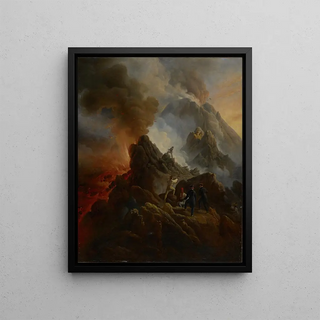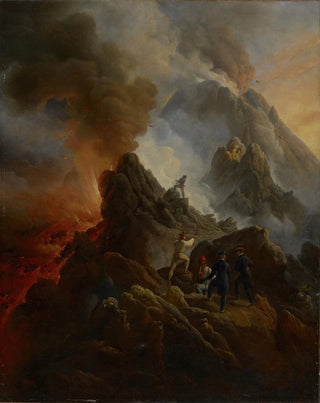Art print | Mount Vesuvius Erupting, the artist and his father Carle Vernet in the foreground - Horace Vernet


View from behind

Frame (optional)
In the rich and varied panorama of art history, some works stand out for their ability to capture not only a moment but also an atmosphere, an emotion. "The Eruption of Vesuvius, the artist and his father Carle Vernet in the foreground - Horace Vernet" is one of those creations that transports the viewer into a world where sublime nature meets family bonds. This painting, a true ode to the power of nature, evokes the majesty of the Neapolitan volcano while placing the figure of the artist, accompanied by his father, Carle Vernet, in the foreground. This compositional choice highlights not only the transmission of artistic knowledge but also the fascination that volcanoes exert on the collective imagination.
Style and uniqueness of the work
Horace Vernet's work is distinguished by its romantic style, where realism and emotion blend harmoniously. In this depiction of Vesuvius, the dynamism of the eruption is captured with striking precision, with the fiery colors of the magma contrasting against the sky darkened by smoke. Vernet uses techniques of light and shadow to emphasize the drama of the scene, creating an atmosphere that is both unsettling and fascinating. The meticulous details of the human figures, especially those of the artist and his father, add a human dimension to this grand spectacle. Their expressions, both of wonder and anxiety, invite the viewer to feel the power of nature while reflecting on man's place in relation to it.
The artist and his influence
Horace Vernet, born in 1789, is the son of the famous painter Carle Vernet, whose influence is felt throughout his career. Although initially trained in his father's footsteps, Horace managed to develop his own style that allowed him to make a name for himself in the artistic world. His passion for depicting historical events and dramatic landscapes earned him international recognition. Vernet was able to capture the spirit of his time, bearing witness to the transformations of society and European landscapes. His work

Matte finish

View from behind

Frame (optional)
In the rich and varied panorama of art history, some works stand out for their ability to capture not only a moment but also an atmosphere, an emotion. "The Eruption of Vesuvius, the artist and his father Carle Vernet in the foreground - Horace Vernet" is one of those creations that transports the viewer into a world where sublime nature meets family bonds. This painting, a true ode to the power of nature, evokes the majesty of the Neapolitan volcano while placing the figure of the artist, accompanied by his father, Carle Vernet, in the foreground. This compositional choice highlights not only the transmission of artistic knowledge but also the fascination that volcanoes exert on the collective imagination.
Style and uniqueness of the work
Horace Vernet's work is distinguished by its romantic style, where realism and emotion blend harmoniously. In this depiction of Vesuvius, the dynamism of the eruption is captured with striking precision, with the fiery colors of the magma contrasting against the sky darkened by smoke. Vernet uses techniques of light and shadow to emphasize the drama of the scene, creating an atmosphere that is both unsettling and fascinating. The meticulous details of the human figures, especially those of the artist and his father, add a human dimension to this grand spectacle. Their expressions, both of wonder and anxiety, invite the viewer to feel the power of nature while reflecting on man's place in relation to it.
The artist and his influence
Horace Vernet, born in 1789, is the son of the famous painter Carle Vernet, whose influence is felt throughout his career. Although initially trained in his father's footsteps, Horace managed to develop his own style that allowed him to make a name for himself in the artistic world. His passion for depicting historical events and dramatic landscapes earned him international recognition. Vernet was able to capture the spirit of his time, bearing witness to the transformations of society and European landscapes. His work






